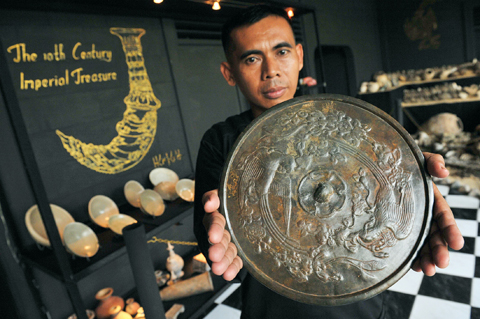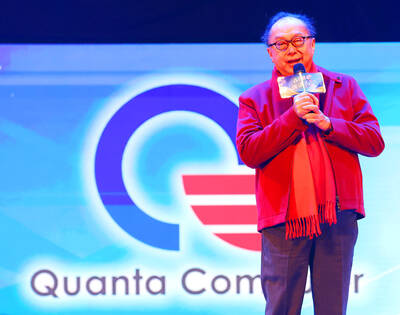An ancient treasure trove salvaged from a 1,000-year-old shipwreck found by Indonesian fishermen is set to go under the hammer in Jakarta on Wednesday with a minimum price of US$80 million.
Belgian treasure-hunter Luc Heymans said the haul was one of the biggest found in Asia and was comparable to the most valuable shipwreck ever found anywhere, that of the Atocha, a Spanish vessel which sank off Florida in 1622.
It includes 271,000 pieces such as rubies, pearls, gold jewelry, Fatimid rock-crystal, Iranian glassware and exquisite Chinese imperial porcelain dating back to the end of the first millennium, or around 976AD.

PHOTO: AFP
“At the time there was a lot of trade going on between Arabia and India and coming down to Java and Sumatra,” said Heymans, who led the salvage effort and subsequent battles with Indonesian officialdom to bring the treasure to light. “But we think there must have been an ambassador on board because so many pieces are imperial Chinese porcelain.”
Descending for the first time onto the wreck site north of Cirebon, West Java, in 2004, the veteran diver said he couldn’t believe what appeared out of the gloom on the sea floor.
“The site was 40m by 40m and it was just a mountain of porcelain. You couldn’t see any wood,” he said.
And not just any porcelain. The pieces include the largest known vase from the Liao Dynasty (907 to 1125) and famous Yue Mise wares from the Five Dynasties (907 to 960), with the green coloring exclusive to the emperor.
Around 11,000 pearls, 4,000 rubies, 400 dark red sapphires and more than 2,200 garnets were also pulled from the depths by Heymans and his team of international divers. It took 22,000 dives to bring it all up but Heymans said the salvage work, from February 2004 to October 2005, was the easy part.
“All the major problems began after we got the stuff on shore,” he said.
The police arrested two of the divers even though Heymans’ company, Cosmix Underwater Research, and his local partner, Paradigma Putra Sejathera PT, had painstakingly arranged survey and excavation licences.
The divers spent a month behind bars before the mix-up was resolved.
There were also run-ins with the Indonesian navy, efforts by rivals to move in on the wreck, a year of litigation and two years of waiting while Indonesia drafted new regulations to govern such work.
Some of Heymans’ backers, who covered him to the tune of US$10 million, began to worry that their investment would be lost at the bottom of the Java Strait, he said.
“I feel some relief now because so many people told me I would never be able to get the permits and get the stuff out of the country,” he said.
He said, however, that it was one of the most difficult ordeals of his career.
By coincidence, officials last week said another treasure hunter who is well-known to Indonesia, Michael Hatcher, is under investigation for allegedly plundering valuable Chinese porcelain from a new wreck.
Indonesian Marine and Fisheries Ministry official Adji Sularso said the probe came after authorities seized 2,360 items dating from the Ming Dynasty (1368 to 1644) that Hatcher was allegedly trying to smuggle out of the country.
The porcelain was loaded in two ships that were intercepted off West Java in September last year.
No charges have been laid but police said on Friday that Hatcher was a fugitive and alerted border officials to block him from attempting to flee the country. His current whereabouts are unknown.

Quanta Computer Inc (廣達) chairman Barry Lam (林百里) is expected to share his views about the artificial intelligence (AI) industry’s prospects during his speech at the company’s 37th anniversary ceremony, as AI servers have become a new growth engine for the equipment manufacturing service provider. Lam’s speech is much anticipated, as Quanta has risen as one of the world’s major AI server suppliers. The company reported a 30 percent year-on-year growth in consolidated revenue to NT$1.41 trillion (US$43.35 billion) last year, thanks to fast-growing demand for servers, especially those with AI capabilities. The company told investors in November last year that

Intel Corp has named Tasha Chuang (莊蓓瑜) to lead Intel Taiwan in a bid to reinforce relations between the company and its Taiwanese partners. The appointment of Chuang as general manager for Intel Taiwan takes effect on Thursday, the firm said in a statement yesterday. Chuang is to lead her team in Taiwan to pursue product development and sales growth in an effort to reinforce the company’s ties with its partners and clients, Intel said. Chuang was previously in charge of managing Intel’s ties with leading Taiwanese PC brand Asustek Computer Inc (華碩), which included helping Asustek strengthen its global businesses, the company

Taiwanese suppliers to Taiwan Semiconductor Manufacturing Co. (TSMC, 台積電) are expected to follow the contract chipmaker’s step to invest in the US, but their relocation may be seven to eight years away, Minister of Economic Affairs J.W. Kuo (郭智輝) said yesterday. When asked by opposition Chinese Nationalist Party (KMT) Legislator Niu Hsu-ting (牛煦庭) in the legislature about growing concerns that TSMC’s huge investments in the US will prompt its suppliers to follow suit, Kuo said based on the chipmaker’s current limited production volume, it is unlikely to lead its supply chain to go there for now. “Unless TSMC completes its planned six

TikTok abounds with viral videos accusing prestigious brands of secretly manufacturing luxury goods in China so they can be sold at cut prices. However, while these “revelations” are spurious, behind them lurks a well-oiled machine for selling counterfeit goods that is making the most of the confusion surrounding trade tariffs. Chinese content creators who portray themselves as workers or subcontractors in the luxury goods business claim that Beijing has lifted confidentiality clauses on local subcontractors as a way to respond to the huge hike in customs duties imposed on China by US President Donald Trump. They say this Chinese decision, of which Agence